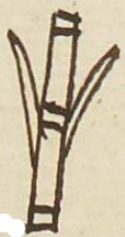acatl (MH483r)
This black line drawing of an element for reed (acatl) has been carved from the compound sign for the personal name, Chicomacatl. The reed here is a vertical cane with divisions of the sort one sees on bamboo or carrizo. It has two leaves, one on either side of the upright cane.
Stephanie Wood
As the contextualizing image shows, this reed is a day sign in a calendrical name that was drawn from the tonalpohualli, 260-day divinatory calendar. Apparently, it was a good day upon which to be born: "They said the good days were Reed, Monkey, Crocodile, Eagle, House" (central Mexico, sixteenth century). See: Fr. Bernardino de Sahagún, Florentine Codex: General History of the Things of New Spain; Book 6 -- Rhetoric and Moral Philosophy, No. 14, Part 7, eds. and transl. Arthur J. O. Anderson and Charles E. Dibble (Santa Fe and Salt Lake City: School of American Research and the University of Utah, 1961), 129.
Stephanie Wood
1560
Stephanie Wood
reeds, canes, carrizos, cañas, plantas

aca(tl), reed, cane, reed-arrow, reed-dart https://nahuatl.wired-humanities.org/content/acatl
la caña
Stephanie Wood
Matrícula de Huexotzinco, folio 483r, World Digital Library. https://www.loc.gov/resource/gdcwdl.wdl_15282/?sp=45&st=image
This manuscript is hosted by the Library of Congress and the World Digital Library; used here with the Creative Commons, “Attribution-NonCommercial-ShareAlike 3.0 License” (CC-BY-NC-SAq 3.0).




